Persistence and dogged tenacity are often prerequisites of bird photography but even then there’s no guarantee of success.
I photographed this Peregrine Falcon ten days ago along the Antelope Island causeway. The perch, some rusty old pipe on the north side of the causeway, is a familiar one to aficionados of the island – it’s a favorite perch of Common Ravens and the occasional raptor. However it’s a long ways from the road/causeway for bird photography so the first 11 images in this post have been cropped to exactly 45% of the original image (the last one is cropped to 49%).
I don’t know the sex of this bird but for the sake of convenience I’m going to refer to it as a male in this post. All images are presented in the order they were taken.
I was far enough from him that my best hope was for takeoff shots where the extended wings of the falcon would fill more of the frame. So I trained my lens on the bird and steeled myself for a long wait. This bird was comfortable! Here I caught him in a yawn as he stood on his left foot while his right one was tucked into his belly feathers in a very relaxed pose.
Soon he gave me a leisurely wing, tail and leg stretch followed immediately after…
by a bilateral wing lift. Resting raptors often stretch just prior to takeoff so I tensed myself for the launch and waited for it to happen. And waited and waited…
But he settled back down into the same resting pose and became a bump on a log (i.e.- pipe) once again. Occasionally he was actually sleeping with his eyelids (not his nictitating membranes) closed.
Five minutes later he stretched again.
And one more time a full four minutes after that.
But this time I had hope there’d be imminent takeoff because…
he also stretched his left wing…
which was followed by another wing lift. I tensed up again and readied myself for launch…
but he returned to his “bump on a log” pose and pretty much maintained it for the next 14 minutes.
Only another bird photographer fully understands the tension and strain involved in such a situation. At this point I’d been squinting at the bird through my viewfinder and had my finger on the half-depressed shutter button for 33+ minutes waiting for him to take off. I had eyestrain and my right arm was at an awkward angle so the muscles were cramping up but I knew if I relaxed even for a moment the falcon would choose that split-second to take off so I persevered. A Peregrine Falcon in flight isn’t a shot I get every day!
Finally he turned on his perch to give me a side view but only for a moment. He was actually in the process of…
turning his back to me. I was very disappointed because it was now most likely that he’d take off away from me and all I’d get would be butt shots.
I can’t remember the exact sequence of events but somewhere in this timeframe a small group of ducks flew overhead from left to right (he was likely watching them when this shot was taken). Fairly quickly after they passed he…
took off after them and actually snagged one of them right out of the air.
After so much time with the falcon (a total of 42 minutes and 412 images) I was very disappointed that this was the best shot I got of the takeoff. The bird is already past me and looking away.
I drove east on the causeway to see if we could locate the falcon with the duck but he’d flown far out onto the ice-covered mudflats and all I could see with the naked eye was a miniscule featureless dot. This is what he and the duck looked like through my 500mm lens.
So I tucked my tail and went home. If you don’t try in these situations you have no chance but trying sure as hell isn’t a guarantee of success.
It’s all part of the game. It can be very frustrating but when we do occasionally succeed the triumph can be so very sweet…
Ron
PS – I didn’t have time to add image techs to these photos but most of them were: 1/2000 – 1/2500, f/7.1 or f/6.3, ISO 500, Canon 7D Mark II, Canon EF 500mm f/4L IS II USM + EF 1.4 III Extender, not baited, set up or called in


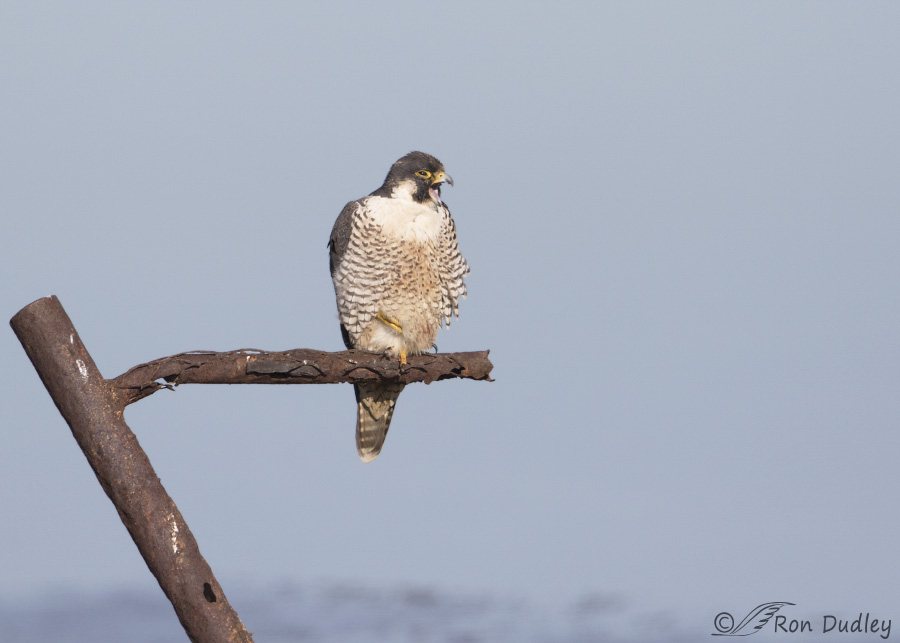
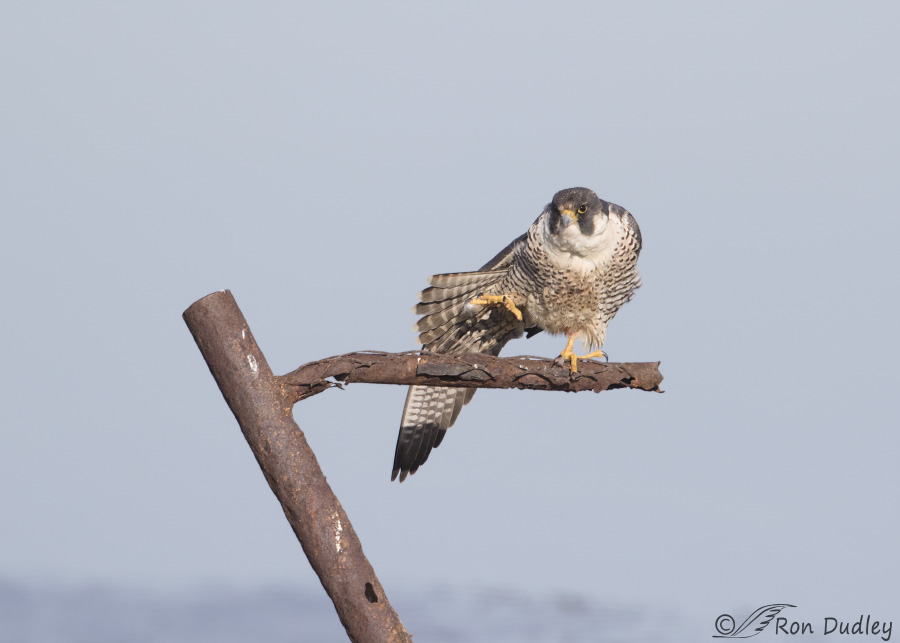
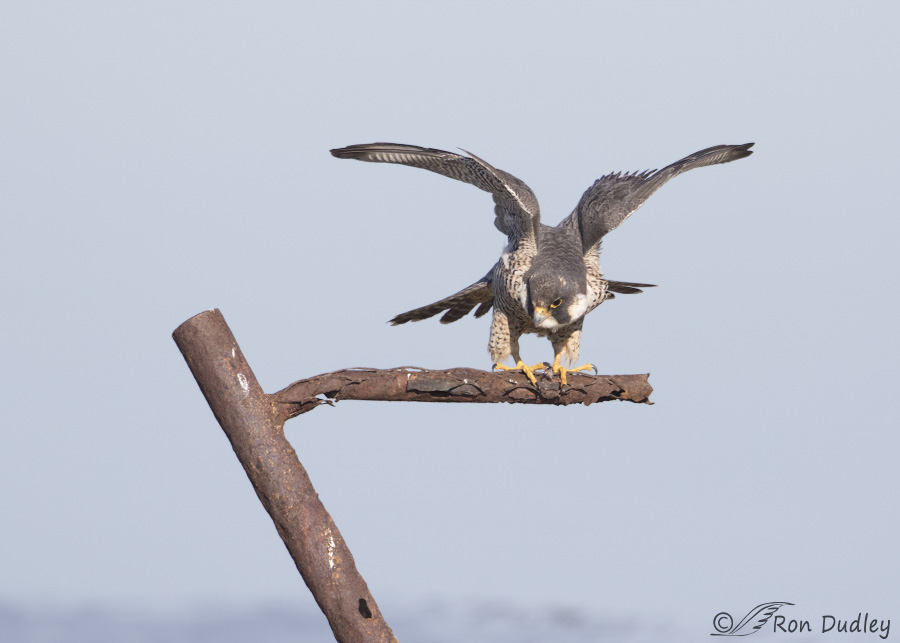
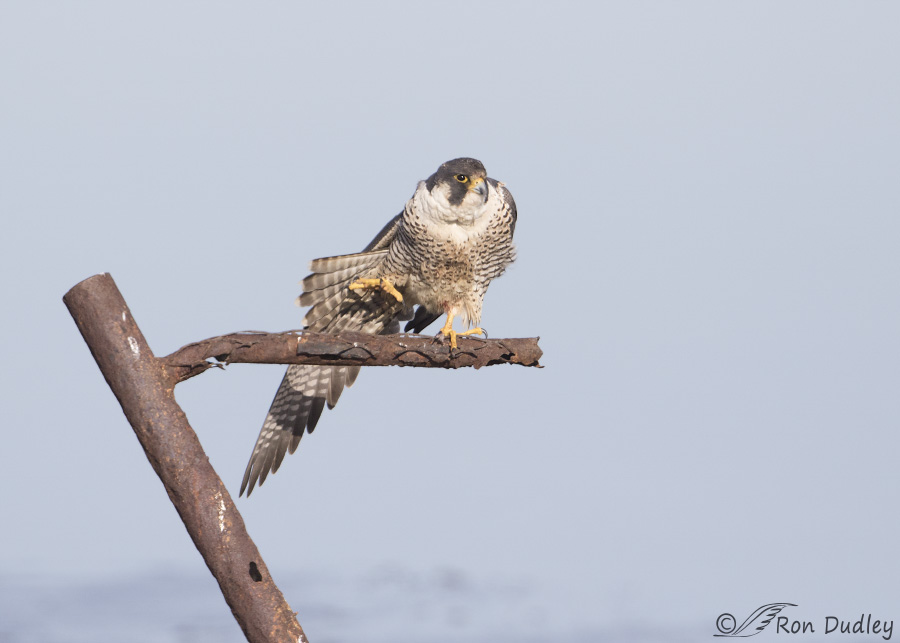
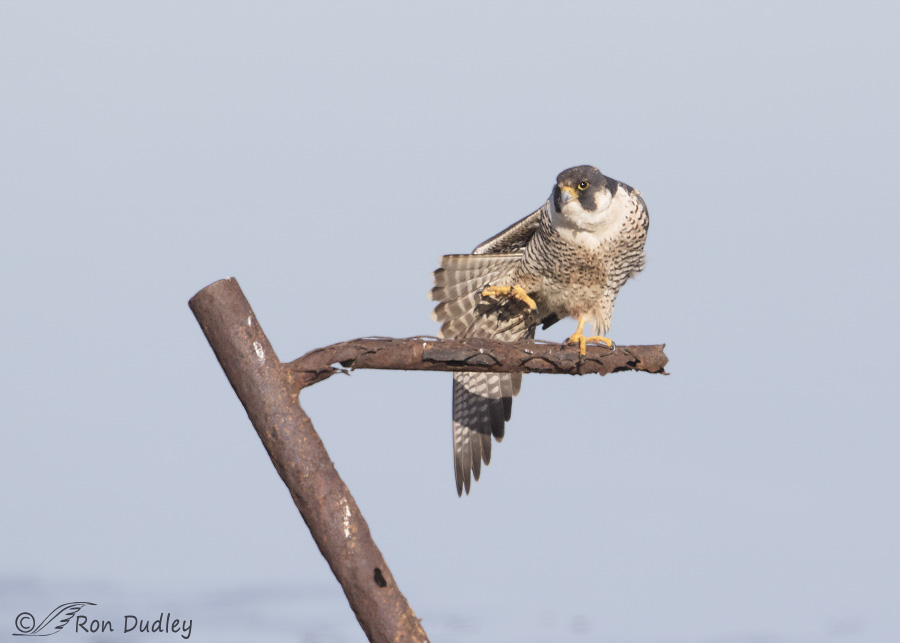
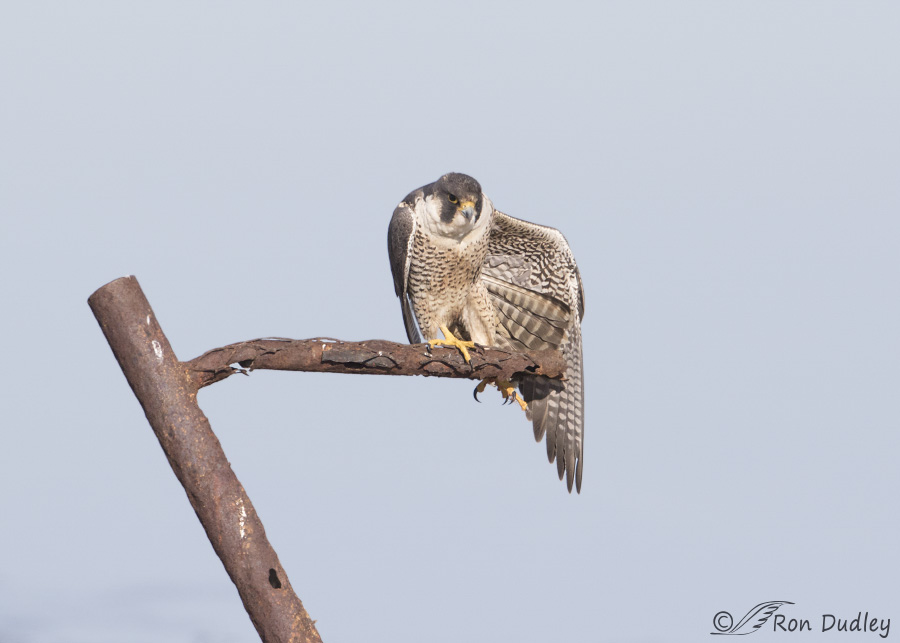
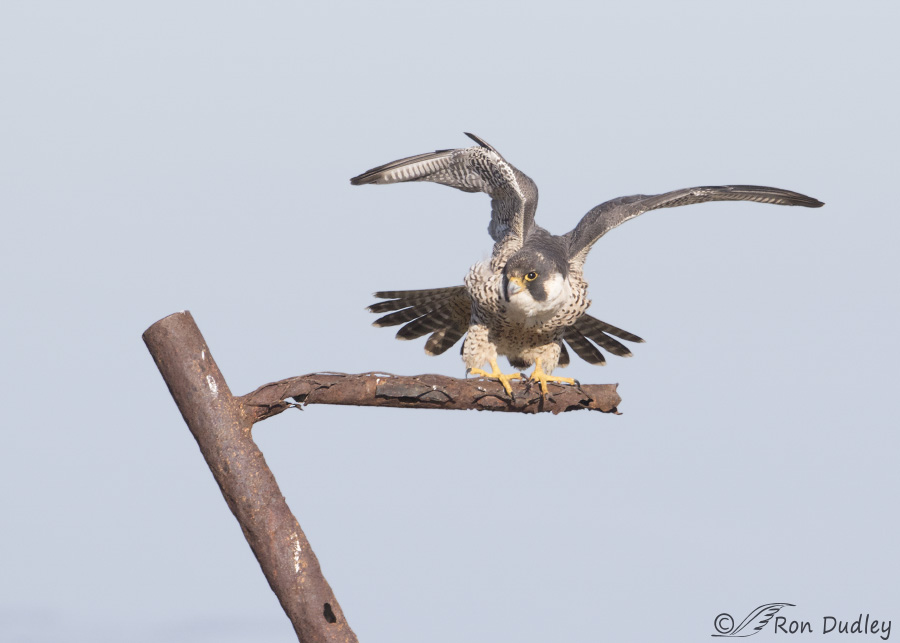
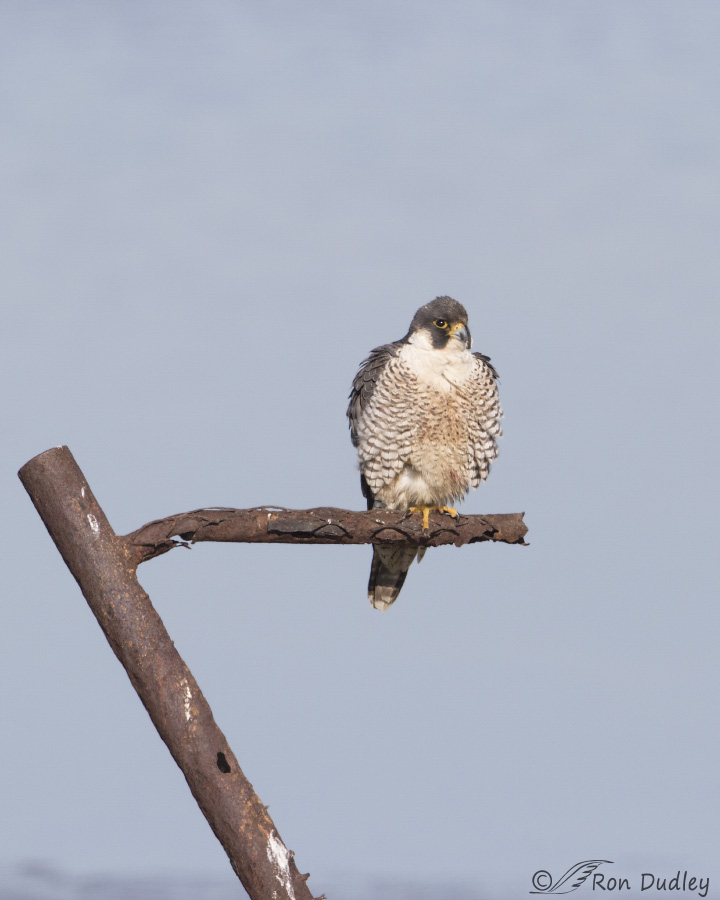
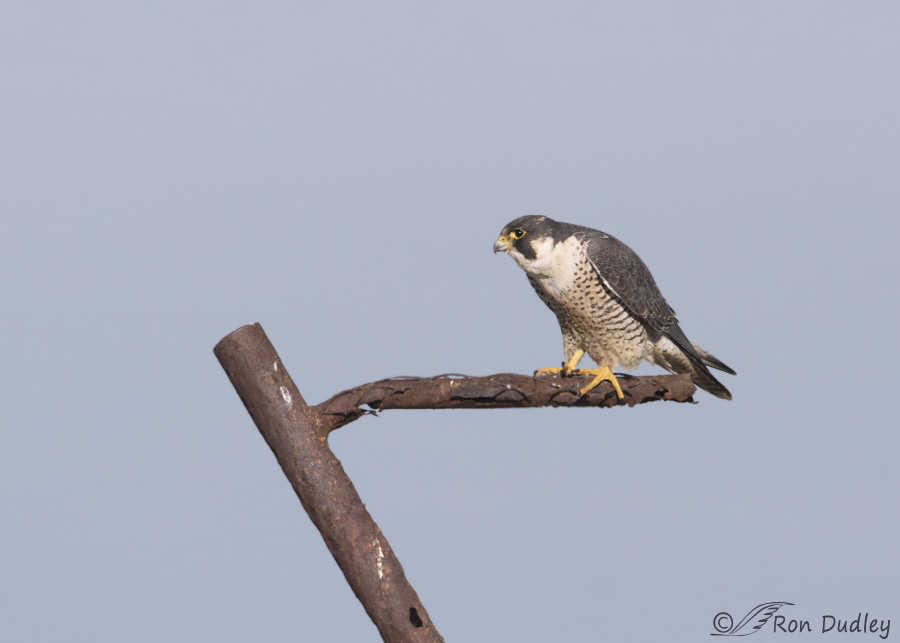
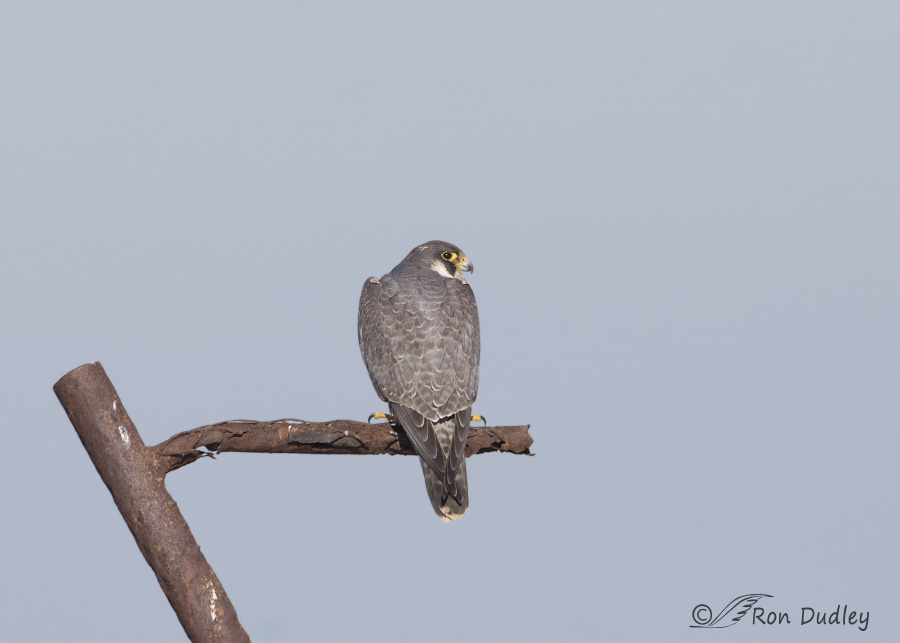
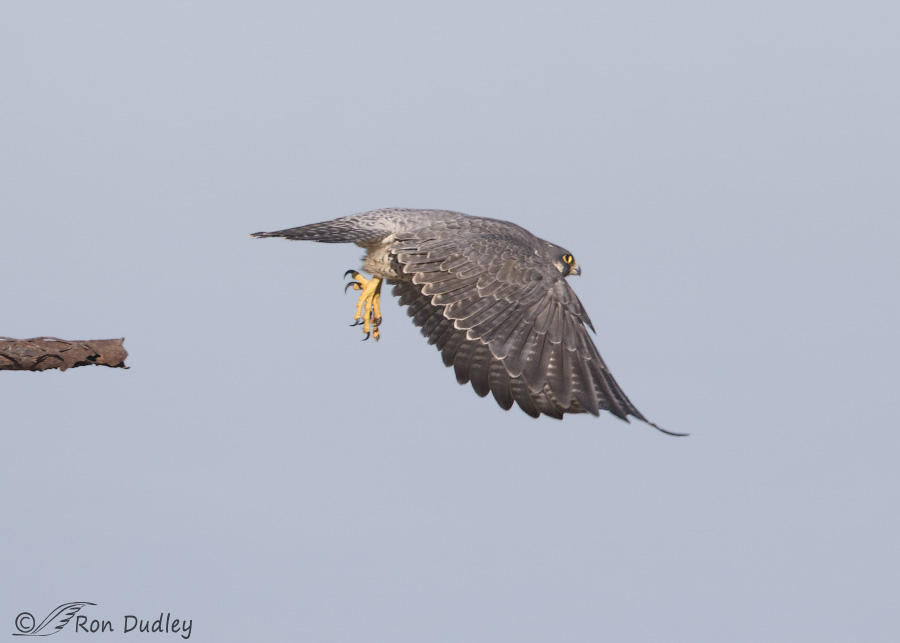
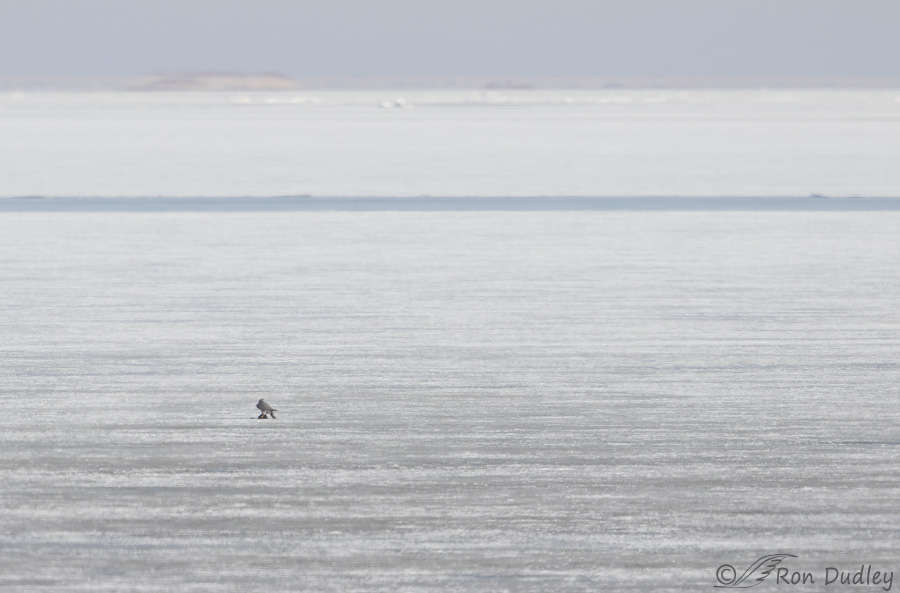
I have 6 lovely pictures of water taken today over half an hour. Missed the duck every time! Know how you feel! Love the peregrine pics and your patience to get them.
Just lovely! Absolutely LOVELY!
Sorry you got punked, but don’t feel like the Lone Ranger. Peregrines (and other raptors) continuously try the patience of falconers, too! It’s what they do because they’re intelligent, cognizant birds who like messing with humans–we’re stupid, we can’t fly and our mothers dressed us funny (from their perspective)! Granted, there’s no real sport in it, but it’s entertaining to them.
Just FYI, in ancient and arcane falconry language, that one-wing, one-leg stretch is called a mantle while the two-wings-over-the-back stretch is called a mantle. Oddly, I haven’t yet encountered an ancient and arcane word for when the bird has one foot tucked up under their feathers, nor for that stretch where they stick out one foot, toes balled. Go figure. However, now you’re ready for “Who Wants to be a Millionaire!” 🙂
Also, if I had to bet, I’d bet this bird is a female, but that said, I wouldn’t bet more than a quarter. The toes are a little too thick and long to be a male. But I’d only bet a maximum of a quarter since what the heck do I know about peregrines? LOL!
Delighted s/he caught a duck in your encounter. That’s an excellent meal on a cold winter’s day!
Amazing Ron! I’m sure that patience is part of what makes you such an outstanding photographer.
Charlotte
Judging from some of your comments and thise of others, bird photography is for the birds….
Nice stretching poses. I enjoyed the commentary. You have patience 33 min! I can’t get my eyes to focus normally after looking through the view finder that long. Someone else would have to drive until my eyes worked at normal distance again.
I have that problem with my eyes too, April. And sometimes I see little dots in my vision after looking through the viewfinder too long.
Your sentiments about this are so familiar! I once stood at my tripod for five hours in 100-degree heat with my camera trained on an osprey nest. It was tense and exhausting. I got a few good shots, but never really the perfect one I’d hoped for. Even at a distance, they seem to know we’re there and (seemingly) want to taunt us at every opportunity!
Yup, a familiar story, Kath. And why I so often say – “bird photography isn’t easy”…
I have been taught: “You miss 100% of the shots you don’t take.” Seems to me you did fairly well!
Thanks, Richard. I sure tried…
I get that this bird was frustrating to you, but I love the stretching poses. And the flight shot. I am amazed by the speed at which raptors can snag prey out of the air. Last year we watched a White-Bellied Sea Eagle go after a pork chop on a line (in Darwin, Australia, when we were on a crocodile tour on the Adelaide River), and even though we were warned how fast the bird would be, I still didn’t see it grab the pork chop and my camera didn’t go off until most of the bird was out of frame.
“my camera didn’t go off until most of the bird was out of frame”
I know that scenario well, Susan – to the point the phenomenon should be named after me!
“Creative language” — what’s that? 😉 That’s still a $&@# fine takeoff shot! I like the way the wings and tail look like a cape around her body. And for you to see her snag a duck in mid-air. Priceless! Plus you have all the acrobatic stretch poses that are so cool. I’d bank this series solidly in the win column! Thank you for your perseverance.
P.S. I do totally understand those “C’mon! Really?! You’ve gotta be kidding me!!!” moments, though.
“$&@# ” – Ha, you got most of the words I used, Marty – but some of them are in the wrong order. And I used several of them twice! 🙂 Thank you.
After 30 years of teaching, I’ve said…whoops…HEARD…them all. 😉
I’m new to your blog and have thoroughly enjoyed your posts–this one included. I’ve been particularly interested to see what you do with your 7D, 100-400 II and 1.4 teleconverter because that is also what I shoot with though I usually shoot without the tc because of the limitations of the tc (f/8 for autofocus and slow focusing). I can imagine your affection for your 500mm but hope you will also use your 100-400 at times.
Curious–when I was reading your commentary about capturing the Peregrine Falcon, I noticed you don’t use back-button-focus and wondered why. Also, I just wondered if your photos are handheld or do you use a monopod/tripod?
Thanks! I look forward to future posts.
Welcome to Feathered Photography, Julie!
Even when I have the 500 I still use the 100-400 fairly often (without the tc), especially when I’m too close to a bird for the big gun.
I WAS using back button focus. I always do. But here my best chance for a takeoff shot I liked was if the bird took off laterally to me. So I prefocused on the bird, took my thumb off the focus button and half depressed my shutter button, and hoped it would take off in the same plane and my shots would be sharp without having AF active and searching. In those situations it seems that if I have my focus points active I lose focus on the bird (especially a rocket-like falcon) way too often.
I’m nearly always shooting from my pickup and using my handy-dandy “noodle” as a lens rest. That’s exactly what I was doing here.
I had to chuckle reading this post and marvel at your persistence! Far better then me – my longest time has been 20+ minutes of waiting before my impatience set in!
Great shots just the same, even the speck on the lake, which gives us a perspective of the distance you are talking about.
Dick, I usually give up before this much time too. But this was a Peregrine Falcon! 🙂
I do understand, I really do!! The only patience I have, it seems, is when I’m carving!! LOL!
Way to stick it out Ron. As you said, the second you put the camera down or look it away it would have flown off 🙂 I like the side on photo that you did capture as it finally flew from the perch!
Thanks, Ed. I know that you fully understand the importance of patience in nature photography!
Lovely series! Given the size of this bird’s feet, the large head on broad shoulders, and the fact that it killed a duck leads me to believe it to be a female. Of course the only proof would be if she’d stopped to lay an egg! But the size difference between male and female Peregrines is usually significant. I’ve seen some females run double the weight of a “normal” sized male.
Mark Runnels agrees with your assessment of sex, Sallie, and partly for the same reason (foot size). Between the two of you I’m convinced.
Based on the foot size, I would be pretty comfortable saying this was a female. Due to the fact that she was primarily in adult plumage with just a few immature body feathers, probably a second year bird.
Beautiful photography…. as usual!
Thanks for that info, Mark. I was wondering about exactly the questions you answered but I don’t have the expertise to make those determinations.
It does take more patience than I usually have! Glad you were able to still get some nice shots of the falcon even if they weren’t what you hoped for! 🙂 Love the yawn and the bird in flight is still great given you got the eye. 🙂
They try my patience too, Judy. A prude wouldn’t have enjoyed my creative language when I missed getting the shot I wanted after all that time trying.
LOL – I also have been known to use some “creative language” as you put it! 🙂
If you wanted him to fly while facing you, you should have looked down at your camera to adjust a setting, inspect the histogram on a test shot or any other activity that would induce a bird to fly while you are not ready. That always seems to work for me!! I hear you loud and clear…
LOL! Right on! 🙂
Boy, you’ve got that right, Zaphir. Even blinking can make you miss the takeoff – especially with lightning-quick falcons!
Wow-you DO have the patience of a saint….your running commentary actually made me laugh–it was almost like watching a clip on TV !
Thank you, Kris. Believe me, if I do that’s the only trait I share with a saint!